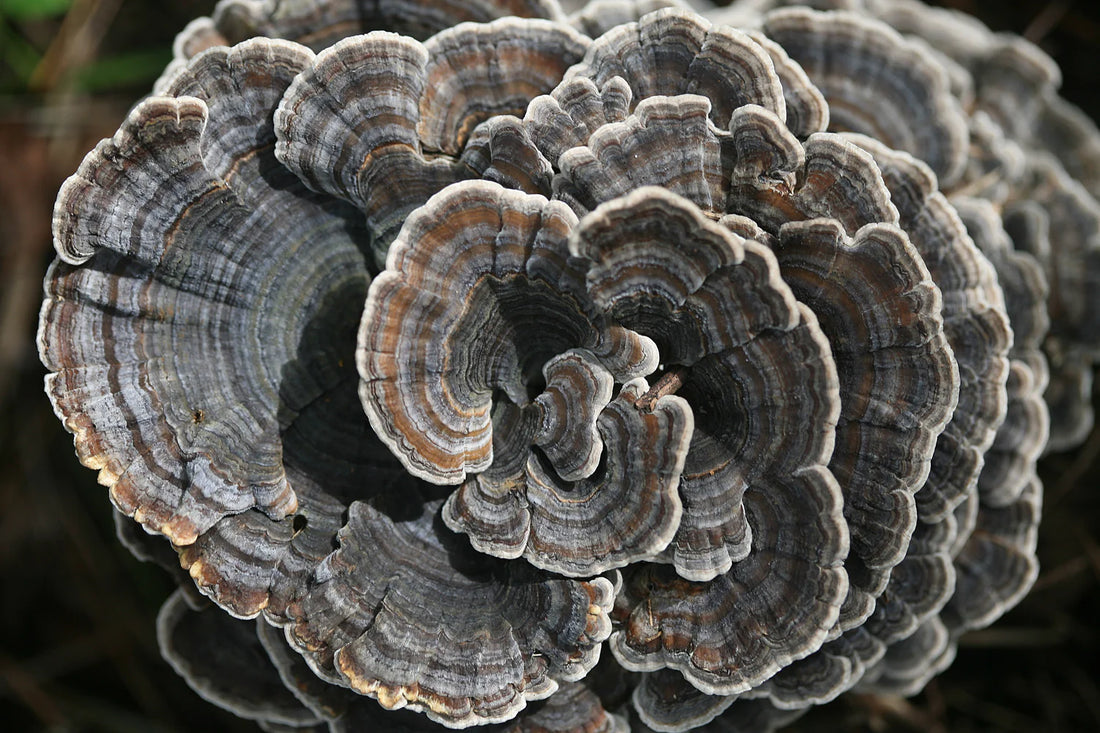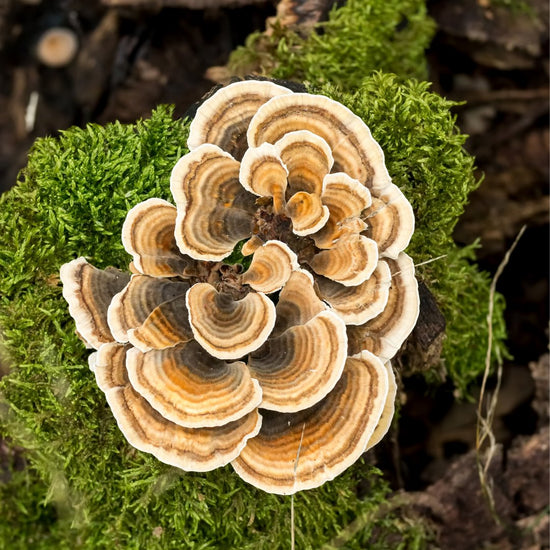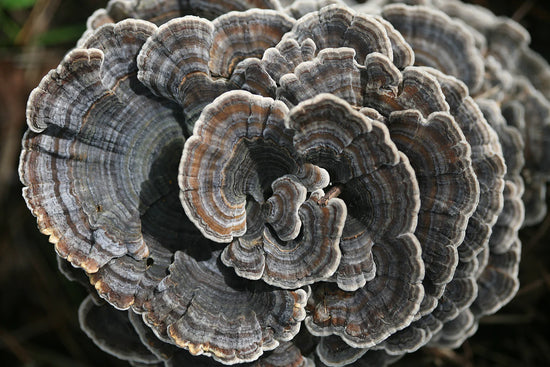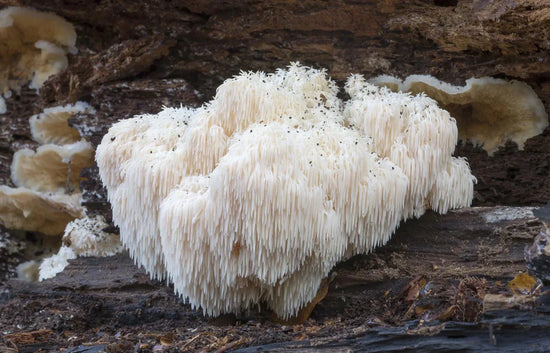Turkey Tail Mushroom Identification: A Simple Technique for Beginning Foragers

With multiple mushroom types that have similar features, the mushroom world can be difficult to navigate. The challenge is especially true if you want to distinguish between the coveted Turkey Tail and similar-looking false Turkey Tail mushrooms.
Are you about to start your foraging journey to find your own Turkey Tail mushrooms? How can you determine which mushrooms are genuine Turkey Tails? And what is the best way to know which are the fake types?
This blog post will help you understand the specific features to look for during turkey tail mushroom identification. If you’re also on the hunt for a replenishing supplement that contains Turkey Tail mushrooms, we have what you need at Mushroom Revival!
The most common lookalike for Turkey Tails
Adaptogenic Turkey Tail mushrooms support your immune system and contribute to an energetic, stress-busting feeling. Identifying Turkey Tail mushrooms when foraging can help you make an authentic beverage using fresh, genuine mushrooms from the wild.
However, there are multiple common lookalike Turkey Tail mushrooms with similar characteristics that can make it difficult to tell between them. When you're next searching for Turkey Tail mushrooms, it's useful to remember the most common lookalikes listed here.
Stereum ostrea
Stereum ostrea mushrooms have bands of color but a slightly redder hue than Turkey Tail mushrooms. You will notice that they do not have pores on the underside of their large, five-centimeter caps, meaning they are types of crust fungus and not polypores. Despite their similar fruiting body to the Turkey Tail mushroom, their leathery, fuzzy texture makes them inedible.
Trichaptum abietinum
Trichaptum abietinum mushrooms have a white or greyish hue that blends with a violet coloration. It is therefore a violet-toothed polypore, meaning it has pores on its cap's underside that look tooth-like in structure and pattern. Trichaptum abeitinum grows on dead wood of conifers to sizes between one and four centimeters, but they are inedible.
Trametes betulina
Trametes betulina has spores on its gill-like underside. Its concentric zones feature various colors, which is why one common name for this mushroom is the "multicolor gill polypore." These wild mushrooms can potentially grow to sizes of 10 centimeters, and you can find them growing on dead deciduous trees and rotting wood. The hairs on their caps and tough, leathery gills make them inedible.
Differences between false Turkey Tail and Turkey Tail mushrooms explained
Multiple differences exist between the true Turkey Tail mushroom and false Turkey Tail mushroom types. If you're preparing to forage and collect true Turkey Tail mushrooms and need to distinguish between them and their lookalikes with the naked eye, here are the characteristics you should observe and consider:
1. Color
The first feature to consider is that a Turkey Tail mushroom's colors range from white and brown to blue and gray. False Turkey Tails, such as Stereum ostrea and Trichaptum abeitinum, do not have this full range of color. For example, when fresh, Trichaptum abietinum may have a white and purplish margin.

2. Shape
While real Turkey Tail mushrooms are fan-shaped and stemless, Turkey Tail lookalikes have unique shapes that set them apart. For example, Trametes betulina has a flat, kidney-shaped form. Trichaptum abietinum are fan-shaped, similar to Turkey Tail mushrooms, but you will notice that they have a toothed underside.
3. Pores
One detail to look for when foraging Turkey Tail mushrooms is their tube-like pores. You may need a magnifying glass! For every millimeter, the mushroom should have between three and eight visible pores. These tiny pores do not resemble the gill-like pores of the Trametes betulina mushrooms. This detail is also a distinguishing factor when you compare real Turkey Tail mushrooms to Stereum ostrea, which do not have pores.
4. Presence of algae
False Turkey Tail fungi may feature green hues that indicate the presence of algae growing on the surface. For example, you will often see a layer of algae on Stereum ostrea mushrooms but less of this substance on real Turkey Tail mushrooms, helping you distinguish them.
5. Growth
True Turkey Tail mushrooms have more plane growth, meaning that they have a flat or leveled surface and are slow-growing. They take one to two months to grow and appear in dense overlapping tiers. On the other hand, false Turkey Tail mushrooms such as Stereum ostrea curve in an upward direction as they grow.

How can you identify Turkey Tail mushrooms?
Five key methods can help you quickly identify Turkey Tail mushrooms.
1. Identify visible concentric zones
Start by checking if the top side of the mushroom has zones that are shaped in circular arcs. Since Turkey Tail mushrooms do not have caps that are a single color, you will need to look for varied colorful arched stripes that look like a turkey's tail. As mentioned, some different shades you should look for include dark blue, purple, red, and brown.
2. Establish if your mushrooms are thin and flexible
Most Turkey Tail mushrooms are thin when fresh and have a thickness of ¼ inch. If you notice that the fresh mushroom is rigid, thick, or hard or thicker than three millimeters, this may be a sign that it is a false Turkey Tail mushroom.
3. Identify how it feels
Determining the texture of the mushroom can help you identify it. Turkey Tail mushrooms have small, fine hairs, which give them a unique texture. Look for a velvety texture when you touch the surface of the cap to confirm that it is a Turkey Tail.

4. Define whether the underside is white
A Turkey Tail mushroom's underside has white-ish or yellow pores. By checking the color of the mushroom's underside and looking for a white or slightly off-white color, you can determine if the mushroom you have found is a real Turkey Tail mushroom. If the underside of the mushroom is brown or yellow, this indicates that it may be one of the Turkey Tail look-alikes.
5. Determine how big the pores are (if they exist)
Since Turkey Tail mushrooms have very fine pores, you can identify turkey tail mushrooms by checking for this characteristic. As mentioned, each millimeter of the surface should contain between three and eight pores. If the pores are a different size or shape, the mushroom you have picked may be a false Turkey Tail.
Benefits of Turkey Tail mushrooms
Turkey Tail mushrooms have support and promote the body's healthy function in many ways. Traditionally, the functional mushroom was used to support well-being and overall health in 14th-century China, and they continue to promote feelings of wellness today. We explore three health benefits of Turkey Tail mushrooms in the sections below.
1. Immune system support
Turkey Tail mushrooms contain beta-glucans 1,3 and 1,6, which can promote healthy immune responses. These mushrooms support a feeling of wellness even in times of immune system challenges and have been traditionally used to support the body's natural immune function.
2. Gut health and digestive tract support
Turkey Tail mushrooms also contain fiber, which plays a key role in supporting the body's digestive system. Prebiotic fiber compounds feed the flora in your digestive tract, which helps support wellness in the gut.
3. Supports the body's natural processes to adapt to occasional stress
Turkey tail mushrooms have adaptogenic properties which is why these mushrooms support the body's natural adaptation process to occasional stress. During times of occasional overwhelming moments, they support your body's adrenal functioning and promote a sense of balance and well-being.
What is the most effective way to consume Turkey Tail mushrooms?
There are multiple effective ways to consume Turkey Tail mushrooms, which extend beyond the traditional Turkey Tail tea method common in 14th-century China. The following options are the most effective ways to consume and use these mushrooms.
1. Capsule
Capsules are perhaps the most popular and effective method for consuming Turkey Tail mushrooms. You can take the capsules that contain Turkey Tail extracts quickly with water.

2. Powder
Powder is another popular and effective consumption method for taking Turkey Tail mushrooms. You'll need to measure out the recommended amount of powder, dissolve it in your juices, coffees, or smoothies, and drink the mixture to consume it.
3. Gummies
Turkey Tail mushroom gummies are a blend of mushrooms and other ingredients in a chewable form. Their pleasant taste makes them another popular and effective way to consume the mushroom, like our Daily 10 Mix Mushroom Gummies.
4. Tincture
Tinctures are bottled blends of Turkey Tail mushrooms in a liquid form with a small pipette. You can consume the liquid by squeezing the recommended number of droplets into a drink you enjoy.
Takeaway
Foraging for Turkey Tail mushrooms can be easy when you know what characteristics to look for. It's worth gathering this mushroom for its many benefits. If you're looking for an easy way to add it to your diet, the best Turkey Tail supplements can be an easier option, but make sure you seek advice from your medical advisor before you take them.
Check our range of Daily 10 Mix products that contain Turkey Tail mushrooms and other common mushrooms, and select multiple packs to receive discounts on your order from Mushroom Revival.



























